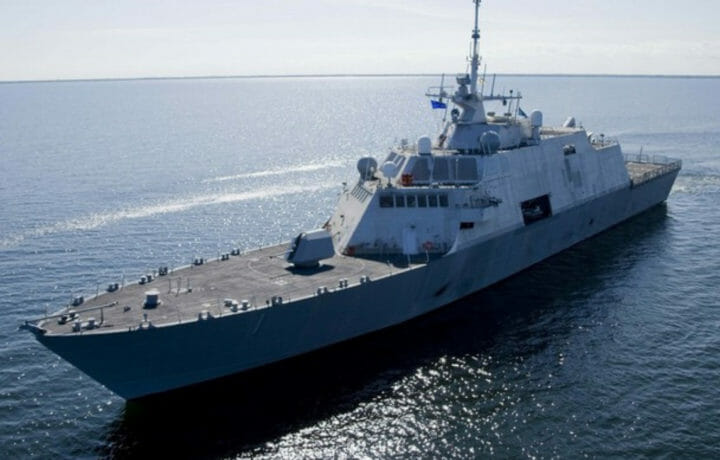Earlier this year, China’s People’s Liberation Army Navy (PLAN) reached a significant milestone. It became the largest navy in the world numerically. Beijing now has a battle force of approximately 350 vessels, yet the majority are still missile patrol boats, corvettes, frigates, and destroyers that are distributed across the northern, eastern, and southern theaters along the coast of China.
While many of these vessels are “multi-role platforms” that are equipped with advanced anti-ship, anti-air, and anti-submarine weapons and sensors, these are still essentially what could be described as a “green water” force – meaning they can operate in waters near China rather than operating as a true “blue water” navy that can sail to distant shores.
The PLAN has undertaken an effort to become a true blue water force with its aircraft carriers and other large warships, but the United States could have an advantage with its support vessels.
The Next-Generation Logistics Ship (NGLS) Program
There are multiple factors that allow the U.S. Navy its ability to operate around the world. These include naval bases around the world from Japan to the Middle East. By contrast, China operates a single support base in Djibouti in the Horn of Africa, while it has been reported that China could be building a facility in Cambodia.
A more significant advantage for the U.S. Navy could be in its logistic vessels, and according to a Congressional Research Service (CRS) report from last month, the Navy’s Next-Generation Logistics Ship (NGLS) program envisages procuring a new class of medium-sized-at-sea resupply ships for the Navy.
The Navy’s proposed fiscal year 2021 (FY21) budget calls for $30 million in research and development (R&D) funding for the program. Congress’s decision on this issue could affect the Navy’s capabilities and funding requirements, as well as the United States shipbuilding industrial based.
Next Generation Ship Concept
Currently, the Navy operates Combat Logistics Forces (CLF) ships, or underway replenishment (UNREP) ships, which can resupply combatant ships, including aircraft carriers, surface combatants and amphibious ships at sea. This enables the combatant ships to continue to operate without having to return to port.
The NGLS program is a new initiative in the FY21 budget submission, and it envisages building a new class of CLF ships that would be medium-sized and thus smaller and individually less expensive to procure the than the Navy’s current CLF vessels. These could be built in two variants, intended to perform specific missions. Much like the Navy’s current CLF ships, the NGLSs would be operated with mostly civilian crews.
The Navy’s proposed FY2021 budget request tallies $30.0 million in R&D funding for the program. Most of this funding would be used for initial industry and Navy studies on the ship. The funding is requested in Project 4045, Next Generation Medium Logistics Ship, within Program Element (PE) 0603563N, Ship Concept Advanced Design, which is line 45 in the Navy’s FY2021 research and development account.
Should this program go forward, contracts for NGLS industry studies would be awarded in the third quarter of FY2021, the contract for designing and constructing or converting the first NGLS would be awarded in the second quarter of FY2023, and construction or conversion of additional NGLSs would follow in FY2024 and subsequent years.
More Modular Warships
The U.S. Navy has also sought to overcome years of setbacks with its Littoral Combat Ship (LCS) Program, which has cost more than $30 billion over the past two decades. This is currently the second-largest U.S. Navy surface ship in production, behind the navy’s Arleigh-Burke-class destroyer program. In 2019, three LCSs were delivered to the fleet while four have been delivered in 2020.
This pace of shipbuilding had not been seen since the 1990s, when the United States Navy began a significant downsizing.
The LCS was designed as a fast, agile, mission-focused platform that could operate in near-shore environments, but also to be capable of conducting open-ocean tasks and addressing 21st century coastal threats including those from submarines, mines and swarming small craft. The LCS is also capable of supporting forward presence, maritime security, sea control and deterrence.
Multiple LCS Variants
The role of the vessels has evolved considerably from when initially conceived to be used purely as a shallow-draft warship in coastal or littoral regions. Lockheed Martin leads the production of the Freedom-variant with odd number hulls while Austal USA produces the Independence-class of LCS with even numbered hulls.
The LCS could be well-suited to operating in areas such as the South China Sea, which has numerous atolls and islands with swallow waters that could be hazardous to larger warships. The LCS can also serve in a variety of missions today, and more importantly, can be easily adapted to serve future and evolving missions. According to Naval News, nearly 40% of the hull is easily reconfigurable, while the modular construction of the platform allows the vessels to be outfitted with additional and evolved capabilities including over-the-horizon missiles, as well as advanced electronic warfare systems and radars.
Despite its smaller size, the LCS platform is actually quite lethal. The vessels are armed with Rolling Airframe Missiles (RAM) and a Mark 110 gun, capable of firing 220 rounds per minute. It can reach speeds in excess of 40 knots, and is ideally suited to operate in waters where deeper draft ships such as destroyers can’t operate in.
Automation is also a major component of the LCS, and it can operate with smaller crews but also utilize both surface and undersea drones that are equipped to hunt sea mines and even patrolling enemy submarines. It could be a critical component of the U.S. Navy of the 21st century.




